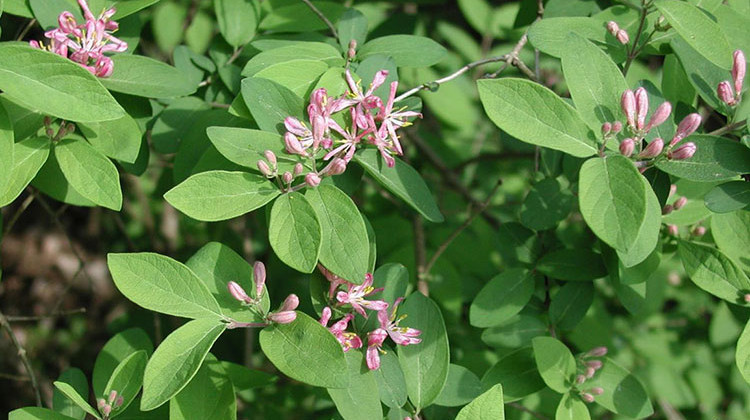
Bell's honeysuckle is one of 44 invasive plant species that will be illegal to sell in Indiana.
Leslie J. Mehrhoff/University of Connecticut, Bugwood.orgBLOOMINGTON, Ind. (AP) — Indiana conservationists are toasting a state commission's decision to make dozens of invasive plant species illegal in the state.
The Natural Resources Commission adopted a rule last week that will prohibit and restrict the introduction, sale, distribution and transport of invasive terrestrial plants into Indiana.
Indiana Native Plant Society President Ellen Jacquart tells The Herald-Times the new rule will apply to 44 highly invasive plant species.
The multi-section rule still needs approval from Indiana's attorney general and Gov. Eric Holcomb, but its provisions will all likely take effect next spring.
The delayed enforcement will give Indiana's plant nursery industry time to rid its stock of invasive plants.
State officials will be educating 350 growers and 3,500 nursery dealers, and the public, about what plants will soon be illegal.
The prohibited invasive plants:
- Achyranthes japonica (Japanese chaff flower)
- Ailanthus altissima (tree of heaven)
- Alliaria petiolata (garlic mustard)
- Alnus glutinosa (black alder)
- Artemisia vulgaris (mugwort)
- Arthraxon hispidus (small carpgrass)
- Berberis thunbergii (Japanese barberry)
- Carduus acanthoides (spiny plumeless thistle)
- Carduus nutans (musk thistle)
- Celastrus orbiculatus (Asian bittersweet)
- Centaurea stoebe (spotted knapweed)
- Cirsium vulgare (bull thistle)
- Conium maculatum (poison hemlock)
- Convolvulus arvensis (field bindweed)
- Coronilla varia (crown vetch)
- Dioscorea polystachya (oppositifolia) (Chinese yam)
- Dipsacus fullonum (common teasel)
- Dipsacus laciniatus (cut-leaved teasel)
- Elaeagnus umbellata (autumn olive)
- Euonymus fortunei (wintercreeper)
- Euphorbia esula (leafy spurge)
- Frangula alnus (glossy buckthorn)
- Hesperis matronalis (dame’s rocket)
- Humulus japonicus (Japanese hops)
- Lepidium latifolium (pepperweed)
- Lespedeza cuneata (sericea lespedeza)
- Ligustrum obtusifolium (blunt leaved privet)
- Lonicera japonica (Japanese honeysuckle)
- Lonicera maacki (Amur honeysuckle)
- Lonicera morrowii (Morrow’s honeysuckle)
- Lonicera tatarica (Tatarian honeysuckle)
- Lonicera x bella (Bell’s honeysuckle)
- Microstegium vimineum (Japanese stiltgrass)
- Morus alba (white mulberry)
- Phalaris arundinacea (reed canarygrass)
- Phellodendron amurense (Amur cork tree)
- Phragmites australis subspecies australis (common reed)
- Polygonum perfoliatum (mile-a-minute vine)
- Reynoutria japonica (Japanese knotweed)
- Reynoutria sachalinensis (giant knotweed)
- Reynoutria x bohemica (Bohemian knotweed)
- Rhamnus cathartica (common buckthorn)
- Vincetoxicum nigrum (black swallow-wort)
- Vincetoxicum rossicum (pale swallow-wort)
 DONATE
DONATE







 Support WFYI. We can't do it without you.
Support WFYI. We can't do it without you.